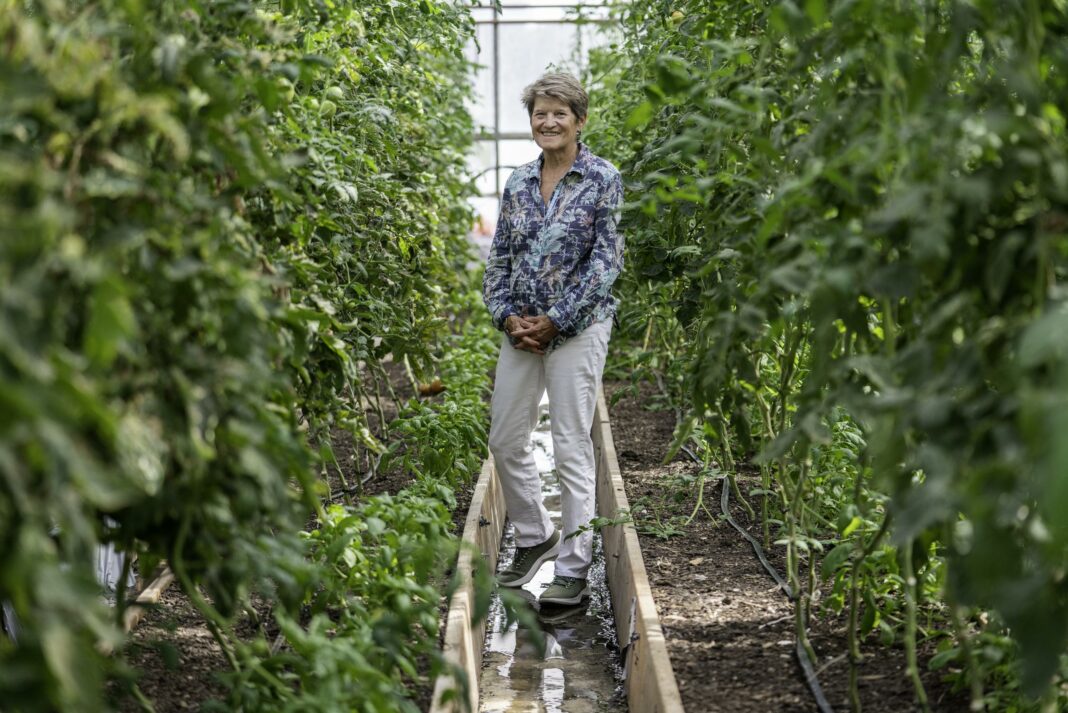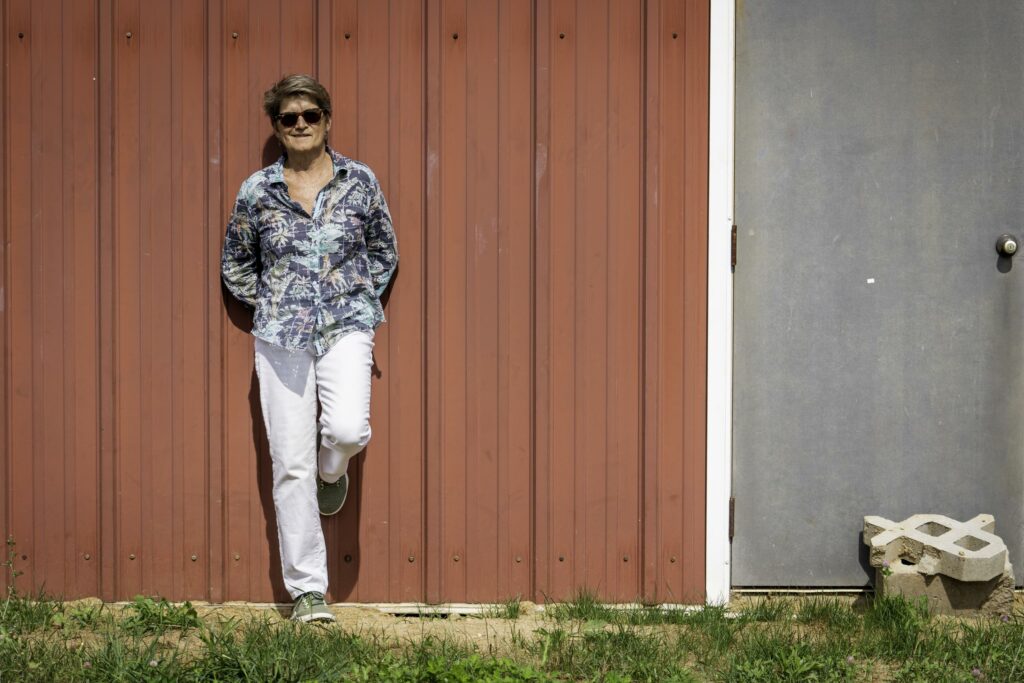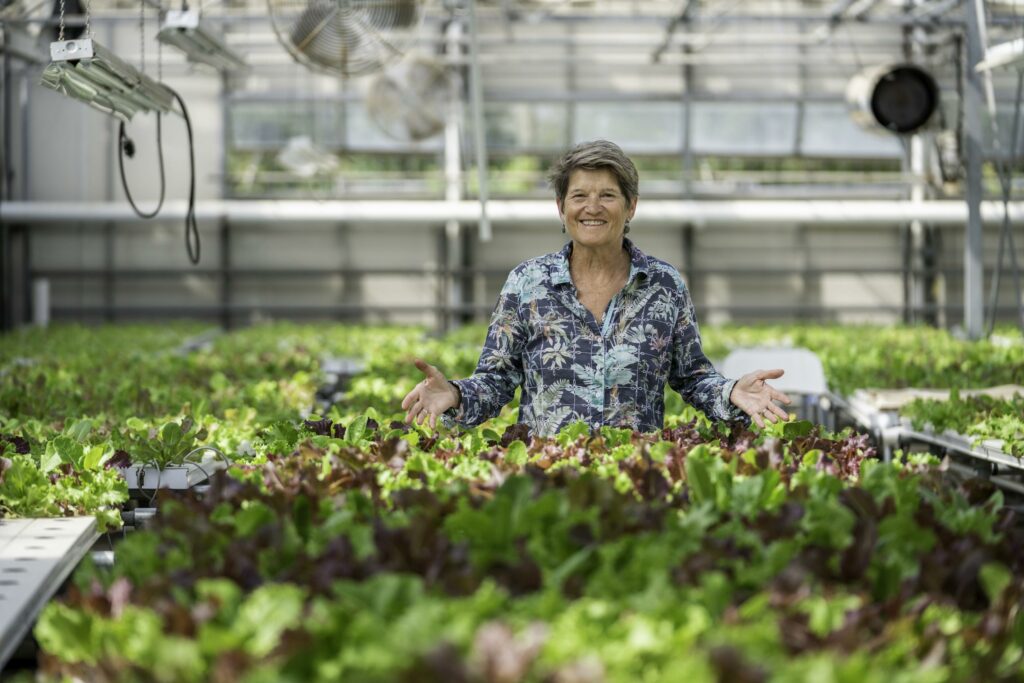The crew at Island Grown Initiative is coming up with solutions to challenges the Vineyard faces around food.
Bluedot Living spoke with Rebecca Haag about her role at IGI, her passion for sustainability and her background in social justice, and how she and her team are approaching the food security and health of our Island right now, and in the years to come.
Bluedot Living: You’re the executive director of Island Grown Initiative. While we all recognize IGI and know it’s vital to the sustainability of our community, can you describe the mission of IGI?
Rebecca Haag: Simply put, we are the food people on the Island. We believe that everyone should have access to education, good healthcare, housing, and food. We are focused on the food part of that. We educate people about food with our Island Grown Schools program and Backyard Growers. We are committed to teaching regenerative agriculture practices which will mitigate climate change and help pull more carbon out of the air. We have a 40-acre teaching farm where we are using only regenerative techniques. Around a third to a half of our produce grown at the farm is used for our food equity programs. We glean food, we have a great group of volunteers who go to fields all around the Island to get fresh produce that is donated through the Food Pantry to those in need. Additionally, we have food equity programs to ensure that everyone on the Island has access to good, healthy food year-round.
BDL: What are some of the major challenges that IGI is hoping to address with their food programs?
RH: A few years ago we merged with the Island Food Pantry and now there are 4,200 registered clients that are a part of our food programs; that’s 20 percent of the year-round population. We have seen a doubling of the demand for food. I think that’s a result of the lack of affordable housing here. People have to pay their rent, they have to pay their utilities, they have to pay for gas so they can take their kids to school and go to work. The one place they can get some relief is food. These are working families on the Vineyard that are in need. Some of them come once or twice a month, and you can see elders who are living on fixed incomes who are coming right before that social security check comes in. Food insecurity can be episodic — if you’re a construction worker and you break your ankle and you can’t work for eight or ten weeks — your family is going to need some support. If you have been diagnosed with cancer and are undergoing treatments at the hospital, you are going to need some support. Any of us could be food insecure at any point in time, and I think COVID really demonstrated that.
We are trying to impact the food system on the Vineyard. We want to get other farmers committed to regenerative agriculture, and we want our farm to be a teaching farm where people come to our property and actually see the results of a regenerative system.
BDL: How is IGI providing education and public awareness to the Island community?
RH: We are trying to impact the food system on the Vineyard. We want to get other farmers committed to regenerative agriculture, and we want our farm to be a teaching farm where people come to our property and actually see the results of a regenerative system. When you utilize regenerative practices, you actually can get more food production per acre, and the traditional value of the produce is higher. We also have to bring along the next generation — kids are actually really interested in where their food comes from, and how they can help the planet. We started Island Grown Schools fifteen years ago, so we are almost seeing the first generation of kids on the Island growing up who have helped grow their own food in their individual school gardens. They have been taught the history of food, the cultural value of food, how food can be cooked in good and healthy ways, and have been encouraged to try things that they might otherwise not try. To watch these kids plant seeds in these community gardens and have the little green seedlings come up, it’s incredibly powerful. For them to see green beans and realize “oh, that’s where green beans come from,” that’s knowledge and experience that will last them their entire lives. Kids can influence their peers, they can even influence the choices their parents might make in their households. For us, food is at the heart of health and wellness, and if we can start teaching the next generation that you are what you eat, we can help promote wellness for a long time into the future.
BDL: Can you describe what’s important about regenerative agriculture?
RH: Regenerative agriculture is meant to bring back and sustain the health of the soil which will then allow it to absorb water and keep minerals in the soil. Once there is life in the soil, that is going to lead to a much richer soil that will lead to a much richer yield of food. Another aspect is that you need to leave the root systems intact so that healthy soil begins to develop. As that soil microbiome gets healthier, it will actually pull down carbon from the air and sequester that into the soil. That’s why we have the farm, because we are implementing all these incredible regenerative techniques and we want to teach people that this is possible, and it’s happening right here.
BDL: How about some specific examples of new and innovative regenerative techniques or technologies that IGI is utilizing?
RH: Andrew Woodruff has always been a part of our farm. He is developing new tools and techniques all the time. [See IGI’s Field Note on page 12.. He created a new seeder that just pokes holes into the ground and we drop the seeds in — there is no plowing that destroys the soil. He is also experimenting with reusable cover plastic for when we rotate crops. Instead of using plastic that you just rip up and throw away, Andrew has invented a roller so we can now reuse all that plastic. He is also looking at the rotations of the crops and how beans are a critical part of returning certain nutrients to the soil. Using cover crops and other regenerative methods, Andrew has found a rotation that will happen over three or four or five years that will enrich the soil. We have also moved our chickens out into the field because you really want to rotate animals as well. All these things are examples of new ways of operating that we want farmers and everyday folks to understand and take on for themselves.
BDL: What’s happening with the food waste/composting efforts? What can Islanders and visitors do to step up their efforts?
RH: We are taking food waste that would otherwise be dumped into the trash and sent off-Island to a landfill somewhere and are diverting that into compost that we have been using to enrich the soil. It seems like such an obvious circle. Why would we ship compost and food to the Island and then ship off food waste when we could be making compost right here. We are probably shipping off more than 6,500 tons of food waste each year. Our composting machine at IGI can process maybe 750 tons a year at its best. There is an organics committee that has been thinking for years about how we can create those composting drums in each town. Our composting machine is going to be offline soon, so we need to think about where we can process a large amount of the food waste. Of course, you can compost in your backyard. As an individual, separating your food waste is essential. Slowly you begin to see how much trash that you pay to take to the dump could be diverted if you separated your food waste into compost bins.
Food is more than just nutrition. It is also love, it is family, it is community, it is tradition and history.
The other important aspect of diverting food waste is shopping. If you are two people, shop for two people. Also, find more creative ways of making leftovers more appealing. How can you turn dinner from the night before into lunch the next day? Learn about the sell by dates on food packaging. If you eat yogurt, the date on the package is the last date you can sell it, but that yogurt will probably be good for another two weeks or so. There are too many consumers that prematurely throw away food. So there are a lot of small changes that individuals can make that actually make a big difference.
BDL: How long have you been at IGI now? How’d you end up in this job and what is your background?
RH: About seven years ago I was chosen as the first hired executive director of IGI. Before that, the board chair had played a big part in running the organization. We were a $750,000-a-year organization with a small staff. Now we are a $3.2 million-a-year organization with a robust education department, and we have created a number of food equity programs that didn’t exist before. We are farming regeneratively, and I think IGI has had a huge influence on the Island; on how people think about growing food, eating food, and respecting the environment. It’s all thanks to the incredible team that we have here. I see my job as the marketeer, out there with the pom poms raising funds and raising interest. When I pitch the work we do at IGI, I pitch it as an investment in the community, in keeping this Island a place where people want to live. Nobody wants to be here knowing that people are going hungry. Nobody wants to be here when they know that school kids in the summer don’t have access to lunch programs.
To watch these kids plant seeds in these community gardens and have the little green seedlings come up, it’s incredibly powerful.
I lived in Boston for many years. I married well — my wife has had a house on the Vineyard since the 70s. For about thirty years we commuted back and forth. She was a PR consultant who did a lot of work around gay marriage, and she spent a lot of time here. We lived in Jamaica Plain, then gave up our house about seven years ago and moved to the Vineyard. I have an MBA, I spent about twenty-five years in business, and then due to certain circumstances got into the nonprofit world. I served as a board member of the AIDS Action Committee of Massachusetts and I loved the work. I realized pretty quickly that my whole business training was focused around the opportunity to work in the nonprofit sector and actually make a difference in the world, so that’s what I was intent on doing.
BDL: Have you always been interested in food? How did you find yourself in this particular field and what do you enjoy about it?
RH: For me, I love to learn about new things. I really started this work knowing that it was part of a social justice agenda. I love to eat, I love to cook, but I am not a farmer or an educator. But I am surrounded by people who do those things. I am mostly like a coach on a baseball team. I can develop strategies on how we need to perform, but I can’t play second base. My team makes it all happen.
BDL: What’s changed during your tenure, both on the Island and at IGI?
RH: I was very pleased at how my staff stood up to the challenges and opportunities of COVID. The pantry could no longer have people coming in so everyone really had to adapt to the situation. People took risks, they were incredibly dedicated to supporting this community. Merging with the Island Food Pantry was a huge change. We have so many amazing organizations on the Island with a very supportive group of donors. But we can’t be inefficient with our resources, and I was very pleased when the president of the board of the Pantry approached us. Trying to get two organizations with different cultures together, we made that happen, and it happened during COVID. I think it was a pretty seamless process.
The farm has changed so much. We were growing hydroponically for a long time, and we had trout for aquaponics. We figured out these things just weren’t sufficient. That’s when we turned to the idea of using the land that we owned, and showing people how regenerative techniques are so important to the sustainability of this Island. We have made major changes over there, and we are in the process of building employee housing as well as an education and innovation center where we will have our offices and a training room. When kids come to the farm, they don’t have a place to shelter when it rains or a place to wash their hands or eat their lunch. We want a real home for our operations, so that’s an exciting development on the horizon.
BDL: Paint us your ideal picture of Martha’s Vineyard in ten years: How are we farming, handling food waste, and making sure Islanders aren’t hungry?
RH: My vision is that there would be four or five big composting drums located in each town, and that we would have people using tabletop containers to take their food waste to the composters. Ideally all the food waste from farms would also go toward making compost. From a growing perspective, we need to encourage the agricultural community. We need to get more farmers, and we need to make more land available for farming. Perhaps most importantly, we need to be resilient and we need to utilize regenerative farming so we can ensure the vitality of our soil here. We are an Island — we can’t deplete our soil and then move onto the next 40-acre field — it just doesn’t exist here.
I would love for the hospital and Island Healthcare to start writing prescriptions for vegetables and healthy food, instead of prescriptions for just medications. It would also be huge for them to become beacons of good food and good health. We want to work together with those organizations to provide that food and also work together to teach people that, in order to be healthy, you need nutritious food. Food is more than just nutrition. It is also love, it is family, it is community, it is tradition and history. I would say that everyone can be part of solving our issue with food by reaching out to their neighbors. Don’t just make some soup for your elderly neighbor or your neighbor who is sick, go sit down and have soup with them. Food is related to people feeling connected and loved.
BDL: Tell us what you like to do when you’re not working. Do you have a favorite natural space on the Island where you like to spend time?
RH: I have three dogs, so we walk everyday. I love Peaked Hill, I love going to the lookout. Just seeing the wonder of the Island is such an amazing treat. I also love cooking and baking. During the winter it’s a lot of having friends over for dinner and spending time with them. I do love to play tennis, and will occasionally head over to the Beach Road Restaurant bar to have a Manhattan.



